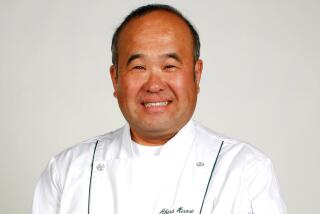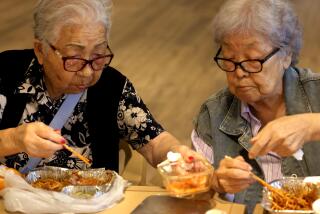A few insider tips for navigating the dining scene
- Share via
Getting the reservation: Your best bet for eating at less touristy places is to make the reservation in Japanese. A hotel concierge can help, but a few smaller, more exclusive places won’t accept reservations made by concierges (because they have so few seats and they want to be sure someone in the party speaks Japanese). If you don’t speak Japanese, ask someone who does to make the call.
Finding your way: In Tokyo, addresses aren’t in numerical order, so you need to know precisely where the restaurant is. Ask the hotel for a map of where the place is, give it to the cab driver and grab the card of the hotel to give to a cab driver for the return trip. When the driver drops you off, it’ll be somewhere in the vicinity, and you probably won’t be able to spot the restaurant. Expect to wander and ask people to help you find it; they are generally very helpful.
How to dress: Diners in all the restaurants were dressed more casually than we had expected -- even in Kyoto’s famous kaiseki temples and at expensive kaiseki and kappo restaurants in Tokyo. Neat and casual is fine, and if you’ll be sitting on the floor, dress comfortably.
Shoe business: Kaiseki restaurants or other restaurants with tatami rooms will ask you to remove your shoes before entering. If you go to the restroom, you’re expected to put on special bathroom slippers at the door. Remember to leave them in the restroom -- it’s easy to forget, and it’s a major transgression to wear the bathroom slippers back into the tatami room.
How to order: Sit at the counter if you can and use Japanese greetings. When the chef greets you with “Irasshai!” (“Welcome”), answer with “Yoroshiku” (“Hello, please treat me kindly”). Order some beer or sake or other drinks and a set menu. Lee Hefter suggests, “Say as best as you can, ‘Omakase’ (chef’s choice), or ‘We eat everything.’ That’s the best way to go because most restaurants in Japan cook that way.”
How do I eat that? If you’re not sure how something should be eaten, ask -- even if you don’t speak a word of Japanese. Often, especially in the soup/rice/pickle course of a kaiseki meal, something might need to be poured into something else and stirred. Asking in pantomime is easier if you sit at the counter. The staff won’t mind if you’re appreciative and interested.
Sushi: Fingers or chopsticks are OK. Ask if the sushi is meant to be dipped (much of the time, it isn’t). If a dip is in order, touch just the edge of fish, not the rice. Don’t mix wasabi into the soy sauce. If you want wasabi, put a bit on top of the fish. Eat a piece of sushi in one bite, if possible; you can ask the sushi chef to cut them in half if they’re too big.
Towels and chopsticks: Rather than a napkin, you’ll be given a hot or cold towel (shibori). Wipe your hands (not your face) with it, fold it neatly and place it to the side, using it like a napkin to dab your fingers during the meal. Place chopsticks in front of you, parallel to the counter, on a rest, if there is one.
Never pour your own sake or beer: It’s your responsibility to keep your companions’ cups filled, and theirs yours.
Essential words that will make a big difference: “Please” (“kudasai”) and “thank you” (“arigato”). Hefter’s favorite always goes over well: “oishii” (“delicious”). Don’t be shy, say it loud and proud. Finally, “itadakimasu” (“Thank you to you and all who prepared it”) or “gochiso-sama!” (“This was a feast.”).
Tipping: The good news is you don’t need to. A service charge is included in the bill.
If you need to cancel: Do so as far in advance as possible. Each restaurant has its own policy. Small restaurants that serve omakase meals sometimes charge for no-shows or last-minute cancellations because they have already purchased the ingredients.
-- Leslie Brenner and Michalene Busico
More to Read
Sign up for The Wild
We’ll help you find the best places to hike, bike and run, as well as the perfect silent spots for meditation and yoga.
You may occasionally receive promotional content from the Los Angeles Times.






